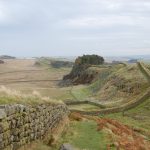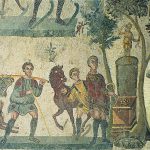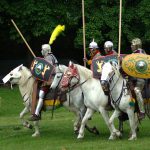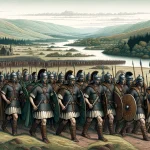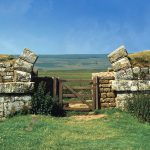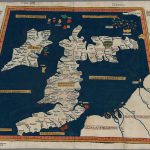Lincoln (Colonia Lindum) Roman Settlement
Aqueduct, Colonia, Legionary Fort, Pottery and Roman-Building
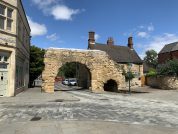
Also known as Colonia Domitiana Lindensium or Lindensivmlindvm. Around AD 80, a fort located here was converted to a colonia after the legion moved on to Eburacum (York) in the year 71. Public buildings, such as the forum (with life-size equestrians statues) and basilica and the public baths, were erected in the 2nd century. The hilltop which was enclosed in the walls of the old Legionary Fort, was largely filled with private homes, but the slopes became the town’s commercial centre. The “Lower town” was also walled. The town had the best developed sewerage system in the province and a fine octagonal public fountain and part of its aqueduct have been partly uncovered.
Classical References to Lindum
The Roman name for Lincoln is well attested in the classical geographies. The Geography of Ptolemy of the early second century says “Next to these [the Cornovii] are the Coritani, among whom are the towns: Lindum 18*40 56?, Ratae 18*00 55?.” The second entry in Ptolemy’s list is Ratae Coritanorum (Leicester, Leicestershire) which was the civitas capital of the Coritani tribe. The name is also recorded in the Ravenna Cosmology of the seventh century, appearing here as Lindum Colonia (R&C#104), between the entries for Venta Icenorum (Caistor St. Edmund, Norfolk) and Bannovalum (Horncastle, Lincolnshire).
Lincoln is also listed in three of the fifteen routes recorded for Britain in the Antonine Itinerary of the late second century, in all cases the name appearing in its dative form Lindo. In Iter V “The route from London to Carlisle on the Wall”, it is listed 24 miles from Causennae (Ancaster, Lincolnshire) and 14 miles from Segelocum (Littleborough, Nottinghamshire). Lincoln is the northern terminus of Iter VI, entitled “the route from London to Lincoln – one-hundred and fifty six thousand paces”, where it is listed at the end of the itinerary, 12 miles from Crococalana (Brough, Nottinghamshire). The last entry for Lincoln is found in Iter VIII “the route from York to London”, again listed 14 miles from Segelocum but this time 14 miles from Crococalana.
The Meaning of the Roman Name
The majority of Roman activity was cantered on a 200 foot (60 metre) hilltop at the end of a limestone ridge overlooking a pool in the River Witham from the north. This was a strategic location, where the Jurassic Way crossed the River Witham, and was the ideal spot for the fortress of the Ninth Hispanic Legion.
The earliest reference to the place-name is from a dedicatory inscription to Fortuna found at Mainz in Germany and dated to the end of Domitian’s reign. This inscription records the name as LINDO, which is the dative form of Lindum. It is very likely that the name Lindum is a Romanised version of the original British, the exact meaning of which is uncertain.
The fore-part of the name lin undoubtedly refers to the pool in the river Witham below the modern castle, which word is recognizable in both modern Welsh (llyn; ‘lake’), and Gaelic (linne; ‘pool’). The Romanised ending -dum, leaves us with some difficulties, however, as the Romans were in the habit of making the local place-names more easily pronounceable to their civilized tongues by giving them this ‘catch-all’ ending. The name (Welsh/Gaelic) for the area could have been Lindo, Lindon, Lindun or even Lindunon, all of which would have different meanings making the etymology uncertain.
When we look at the possible endings of the name in the various old languages of Britain, we see that there are two general possibilities;
- Referring to a settlement or fortification on the hill overlooking the pool;
- Gaelic; dun ‘fort’, ‘castle’.
- Welsh; din ‘hillfort’; dinas ‘citadel’; dyn ‘enclosure’.
- Old English; dun ‘high place’, (note Irish dun, m. a fortified hill), and tun ‘town’.
- In reference to the colour or opacity of the pool itself;
- Gaelic; dubh ‘black’; donn ‘brown’.
- Welsh; du, ddu ‘black’, ‘dark’.
The scarcity of Iron-Age remains recovered from the hill top at Lincoln make it unlikely that a pre-Roman native iron-age encampment existed here, and point to it being a virgin site when the Romans first arrived in the area. This being the case, the first group of endings listed above, although attractive, may be discounted. It is probable, on the face of it, that the ancient name (Welsh/Gaelic) for Lincoln was something along the lines of Lin-du, meaning ‘The Dark Pool’. There are many reasons why this widening in the Witham would be called ‘The Dark Pool’ by the ancient Britons; it is possible that the waters of the Witham were tinged dark-brown by the peaty soil through which it flowed, it could allude to the depth of the river-pool, or the fact that in the mornings it is overshadowed by the hills to the east.
A colony of veteran soldiers was established at the end of the first century, and Lindum was then renamed Colonia Domitiana Lindensium. Following the assassination of the deranged emperor Domitian in September 96AD, and the condemnation of his memory by the Senate, the colony became known simply as Lindum Colonia, which over the ages has been contracted to its modern form, Lincoln.
The Legionary Fortress
The fortress defences were aligned east-west and consisted of a single ditch and rampart which enclosed an area of around 41 acres (16.6 hectares). The rampart consisted of a double row of turves with the space between the two walls filled with the outcast from the ditch. The rampart was surmounted by a timber palisade and walk-way, and timber was probably used to strengthen the front and back of the turf walls.
There were four gates set at the cardinal points in the walls, the north and south gates being slightly off-set to the east; the fortress therefore faced west into the then troublesome region of the Peak District in Derbyshire and North Staffordshire.
The legionary fortress had originally been established as the base of Legio IX Hispana c. A.D. 70, but by the end of the decade they had been replaced at Lindum by Legio II Adiutrix. The fortress was abandoned with its defences intact c. A.D. 79, when the agressive policies of the governor Agricola had moved the scene of action far to the north in Caledonia.
Aside from the fortress of the Ninth at Lincoln, there is a large Roman ‘vexillation’ or campaign fortress at Newton on Trent about 10 miles due west.
Legionary and Auxiliary Units at Lincoln
RIB 257 - Funerary inscription for Gaius Valerius
Gaius Valerius, son of Gaius, of the Maecian voting-tribe, soldier of the Ninth Legion, standard-bearer of the century of Hospes, aged 35, of 14 years’ service, left instructions in his will for this to be set up. Here he lies.
MAEC MIL LEG
IX SIGN C HOSPITIS
ANN XXXV STIP XIIII
T P I
H [...]
No commentary.
RIB 255 - Funerary inscription for Gaius Saufeius
To Gaius Saufeius, son of Gaius, of the Fabian voting-tribe, from Heraclea, soldier of the Ninth Legion, aged 40, of 22 years’ service he lies here.
G F FAB HER
MILITI LEGIO
VIIII
ANNOR XXXX
STIP XXII
H S E
2. Heraclea, in Macedonia.
RIB 249 - Funerary inscription for Marcus Aurelius [...]us
Marcus Aurelius […]us, freedman of Marcus Aurelius [Max]sumus, of […]cinum, aged 35 (or 45 or 85), […]si(us) […]lenius, veteran from the Fourteenth Legion [Gemina], his heir, set this up in accordance with his will.
[6]VS M AVRE
[...]SVMI LIB
[4]CINO
[...]XXXV
[6]SI
[...]LENIVS VE
[...] EX LEG XIIII
[...] H E TEST P
4. …]cino For this place-name Ticinum (Italy, reg. xi) is too short; Barcino (Hisp. Tarrac.) should be Barcinone (in abl.), or be abbreviated to Barcin. or Barc. R.P.W.
RIB 258 - Funerary inscription for Titus Valerius Pudens
Titus Valerius Pudens, son of Titus, of the Claudian voting-tribe, from Savaria, a soldier of the Second Legion Adjutrix Pia Fidelis, in the century of Dossennius Proculus, aged 30, of 6 years’ service here he lies. His heir at his own expense set this up.
CLA PVDENS SAV
MIL LEG II A P F
𐆛 DOSSENNI
PROCVLI A XXX
AERA [...]I H D S P
H S E
Savaria: (Stein am Anger or Szombathely) a Claudian colony in Pannonia Superior. The recruitment of much of leg. II A P F from the fleet may account for the trident and dolphin in the gable.
RIB 252 - Funerary inscription for Gaius Julius Calenus
To the spirits of the departed (and) of Gaius Julius Calenus, of the Galerian voting-tribe, from Lyons, veteran from the Sixth Legion Victrix Pia Fidelis his heir made this to the memory of him.
G IVLI GAL
CALENI LVG
VET EX LEG VI
VIC P F H A SE M F
Calenus is the name of an Aeduan ( iii 35), and of a potter who also used a stamp galen (Oswald Stamps). Lugdunum, now Lyons, the capital of Gallia Lugdunensis.
RIB 266 - Funerary inscription for a decurion of the Second Cavalry Regiment of Asturians
… once decurion of the Second Cavalry Regiment of Asturians, lived 70 (or more) years.
[...]EC ALAE II
[... ]NNIS LXX[.]
Watkin wrongly assigns it to Hungate.For ala II Asturum see RIB 1463, &c. (Chesters).
It must be pointed out that tombstones are not very good indicators for the presence of a military unit. This is because the highly-trained soldiers in a legion, particularly the centurions and other non-commissioned officers, were very much in demand, and were often posted to other legions or auxiliary units in order to train recruits, oversee building operations, or to act in some other advisory capacity. There is no way to tell if the legions mentioned on the tombstones shown above were actually present at the Lincoln fortress, because the individuals involved may have been temporarily posted here from another unit. There is a further complication caused by the establishment of the colonia, which would have accepted veteran soldiers from all of the British legions, thus the epitaphs may belong to veteran colonists, again negating the need for their respective units to be actually stationed here at any time.
Colonia Domitiana Lindensium
A Colonia was established during the reign of the notorious emperor Domitian in the late 90s for demobilized veterans, who occupied the evacuated fortress, the site of the old praetorium being used for the new, timber-built forum and basilica.
The colonists almost immediately strengthened and embellished the old fortress with a stone cladding four feet (1.2 metres) thick along the entire outer wall of rampart. The gates were also clad in stone at this time. The work was not very well realized however, as no foundations had been used, and part of the wall overlay the legionary ditch, which had been hastily in-filled. As a result of this shoddy workmanship, the newly-built colonia walls soon began to lean outwards.
All four gateways were re-built on a monumental scale in c.220-30AD. A major part of the west gate from this period survives to this day, incorporated into the defences of the later Norman castle and forming its principal north-western entrance. It is thought that the earlier ‘jerry-built’ stone outer walls of the colonia were re-visited at the same time the monumental gateways were constructed, some-parts being strengthened and refurbished, other parts being completely rebuilt.
The Adjoining Civil Settlement
A settlement consisting mainly of native Coritanian Britons and skilled artisans from further afield, had been established to the south of the fortress since the late first century, forming a canabae between the south wall of the fortress and the River Witham. The civil settlement continued after the legionary fortress had been abandoned, and since the founding of the colonia had spread downhill thoughout the second century.
In the early third century (c.200AD) the adjoining civil settlement was enclosed by a low rampart and ditch, which extended south from the south-east and south-west corners of the fortress almost down to the river. At first these defences were backed by a simple wooden palisade or fence, set about ten feet behind the rampart, which was later augmented by the addition of a narrow wall atop the bank. With the additional area thus enclosed, the size of the colonia was more than doubled to about 100 acres (40 hectares).
In addition to the colonia in the old fortress and the walled town to the south, there were extensive suburbs outside the north, east and west gates of the old fortress, and outside the gates set roughly central in the east and west walls of the lower town.
A small settlement on the south side of the River Witham extended along either side of Ermine Street for over half a mile (1 kilometre). This later developed into a major industrial centre.
Some Roman Tombstones from Lincoln
RIB 251 - Funerary inscription for Flavius Helius
To the spirits of the departed: Flavius Helius, a Greek by race, lived 40 years. Flavia Ingenua set this up to her husband.
FL HELIVS NATI
ONE GRECVS VI
XIT ANNOS XXXX
FL INGENVA CO
NIVGI POSVIT
No commentary.
RIB 262 - Fragmentary funerary inscription
For Carssouna see Holder s.v. Carasounus, Carassounus, Caraddouna, Carathounus.For the formula nomini see A. Brelich Dissertationes Pannonicae ser. 1, fasc. 7 (1937) 71.Hueb. IBC corrects his suggestion that it belongs to the sixteenth century, and assigns it to the seventh or eighth. Wordsworth assigns it to the eleventh, and Bruce Dickins to the late eleventh century, which accords with the architecture.Grateful acknowledgement is made by the Junior Editor to Professor Bruce Dickins and to Dr. B. Colgrave for discussion of the Anglo-Saxon text.
RIB 263 - Funerary inscription for Claudia Crysis
To the spirits of the departed (and) to Claudia Crysis she lived 90 years. Her heirs had this set up.
CLAVDIAE
CRYSIDI
VIXIT
AN LXXXX
HEREDES
P C
No commentary.
The Gods of Roman Lincoln
For some obscure reason the gods are not very well represented at Lincoln, there being only three known altars dedicated to various deities, and two other inscriptions of a quasi-religious nature. All of these texts are reproduced on this page, the most interesting altarstone being RIB 247 shown above.
RIB 247 - Altar dedicated to the Fates and the Divinities of the Emperors
To the Goddesses the Fates and the Divinities of the Emperors Gaius Antistius Frontinus, guild-treasurer for the third time, dedicated this altar at his own expense.
BVS ET NV
MINIBVS AVG
G ANTISTIVS
FRONTINVS
CVRATOR TER
AR D S D
For the expansion of Aug. as Aug(ustorum) see note to RIB 152. Haverfield dated the lettering to the Severan age.
Suspected Classical Temples at Lincoln
One site just off Lincoln High Street has produced column bases and finely-worked large stones together with an inscription mentioning the god Mercury (vide RIB 270 supra); It is possible that these artefacts came from a classical temple dedicated to this messenger god. Also at the Bailgate site on the west side of the main north-south street beside the basilica and forum, a monumental building with a facade possessing six 20 ft. tall columns across the front (hexastyle), is thought to represent a classical temple perhaps dedicated to the Imperial cult.
RIB 270 - Fragmentary inscription
The … ward of the guild of Mercury.
For similar vici see CIL xiii 6723 (ILS 7082), CIL xiii 6688 (ILS 7083) Mainz; Schmid, BRGK 15 (1926) 218 (Pettau); CIL iii 6837 (ILS 5081) Antioch in Pisidia; CIL xi 379 (ILS 6664) Rimini.
Fourth Century Decline
As the colonia and town developed through the third into the fourth century, the majority of the population had gravitated into the suburbs. It is suggested that this was due primarily to the large area taken up by the administrative and public areas of the town such as temples, fora and basilica, in addition to the large, sumptuous town-houses of the local nobility and land-owning classes. With the degeneration of the road system in the fourth century, and the increasing dependence on the River Witham to conduct commercial trade, the population was concentrated along both banks of the river.
In the late fourth century, it is of interest that in certain areas of the walled town and fortress, ruined buildings were levelled and then covered with a thick layer of “Dark Earth”, presumably for the use of agriculture or gardens.
Although the town suffered a partial decline in the fifth century, occupation continued through the Saxon period and the Norman castle built into the south-west corner of the old legionary fortress provided the security needed for the town to survive through the middle ages to the present time.
Roman Milestones from Lincoln
RIB 2240 - Milestone of Valerian
For the Emperor Caesar Publius Licinius Valerianus Pius Felix Augustus, pontifex maximus, with tribunician power, father of his country, the municipality of Lindum (set this up).
P L[...] VALE
RIANO PIO
FEL AVG P
M TR P P P
RP L
Valerian, A.D. 253-9.It marked the first mile on the Fosse Way, leading south-west to Leicester (Ratae). But cf. Brit. 6 (1975), 88 with n. 36, which asserts it was ‘found at Lincoln, a mile south of town, alongside Ermine Street‘.
A couple of Roman milestones or honorific pillars have been recovered from the Lincoln environs, and the texts of both are displayed here. One of these honorific pillars has been used twice, the primary text being completely erased before the secondary was inscribed, the surviving text is extremely interesting, however (RIB 2241 infra).
RIB 2241 - Milestone of Victorinus
For the Emperor Caesar Marcus Piavonius Victorinus Pius Felix Invictus Augustus, pontifex maximus, with tribunician power, father of his country, from Lindum to Segelocum 14 miles.
The primary text has been chiselled off, but traces of it can be seen, especially below the last line of the secondary text.Victorinus, A.D. 268-70.Segelocum (Littleborough) lies on the River Trent 14 Roman miles (20.7 km.) north-west of Lindum (Lincoln) (cf. It. Ant. 475, 3 and 4).
References for Colonia Domitiana Lindensivmlindvm
- The Towns of Roman Britain by John Wacher (2nd Ed., BCA, London, 1995) pp.132-150 & fig.57;
- Chronicle of the Roman Emperors by Chris Scarre (Thames & Hudson, London, 1995);
- Chronology of the Ancient World by E.J. Bickerman (Thames & Hudson, London, 1980);
- The Romans in Britain – An Anthology of Inscriptions by A.R. Burn (Blackwell, Oxford, 1969);
- Temples in Roman Britain by M.J.T. Lewis (Cambridge 1966);
- The Roman Inscriptions of Britain by R.G. Collingwood and R.P. Wright (Oxford 1965).
- Air Reconnaissance of Southern Britain by J.K. St. Joseph in J.R.S. xliii (1953) pp.81-97;
- Atlas of the Greek and Roman World in Antiquity by Nicholas G.L. Hammond (Bristol Classical Press);
Roman Roads near Colonia Domitiana Lindensivmlindvm
Iter V: Ermine Street: S (17) to Ancaser (Ancaster, Lincolnshire) Itinera VI/VIII: SW (11) to Crococalana (Brough, Nottinghamshire) E (22) to Horncastle Ermine Street: N (10) to Owmby (Lincolnshire) Itinera V/VIII: NW (14) to Marton (Lincolnshire) SSE (17) to Sleaford (Lincolnshire) Ermine Street: N (5) to Scampton
Sites near Lincoln (Colonia Lindum) Roman Settlement
- Greetwell Villa (2 km)
Quarry and Villa - Scampton Villa (7 km)
Villa - Owmby Settlement (15 km)
Minor Settlement - Newton-on-Trent Marching Camp 1 and 2 (15 km)
Marching or Temporary Camp - Newton-on-Trent Marching Camp 1 and 2 (15 km)
Marching or Temporary Camp - Newton On Trent Roman Fort (15 km)
Vexillation Fort - Norton Disney Villa (16 km)
Villa - Marton Roman Fort (18 km)
Auxiliary Fort - Crococalana Settlement (19 km)
Major Settlement - Cromwell Villa (20 km)
Villa
